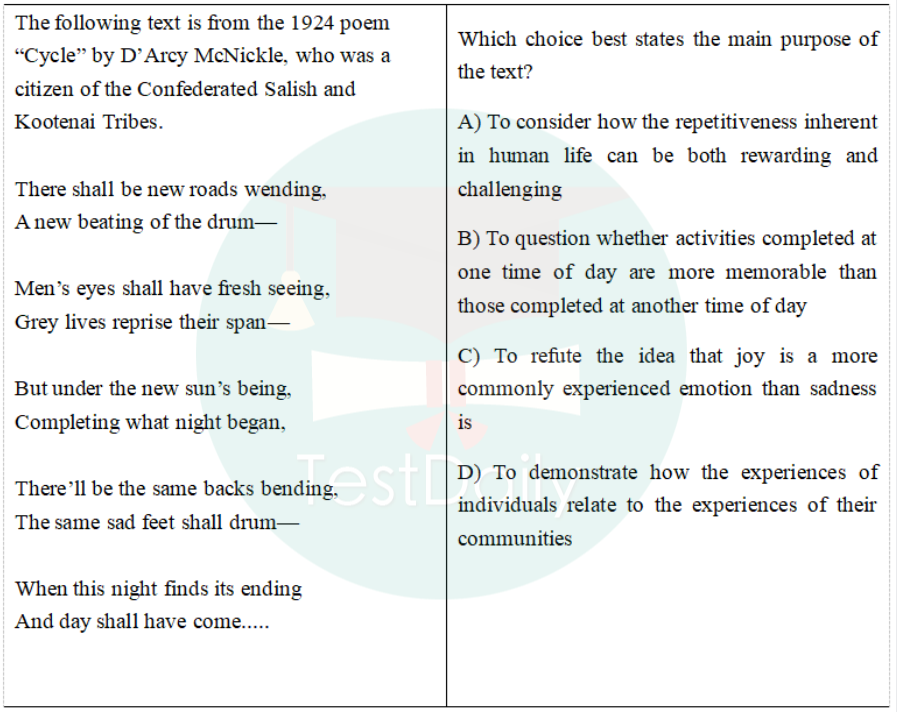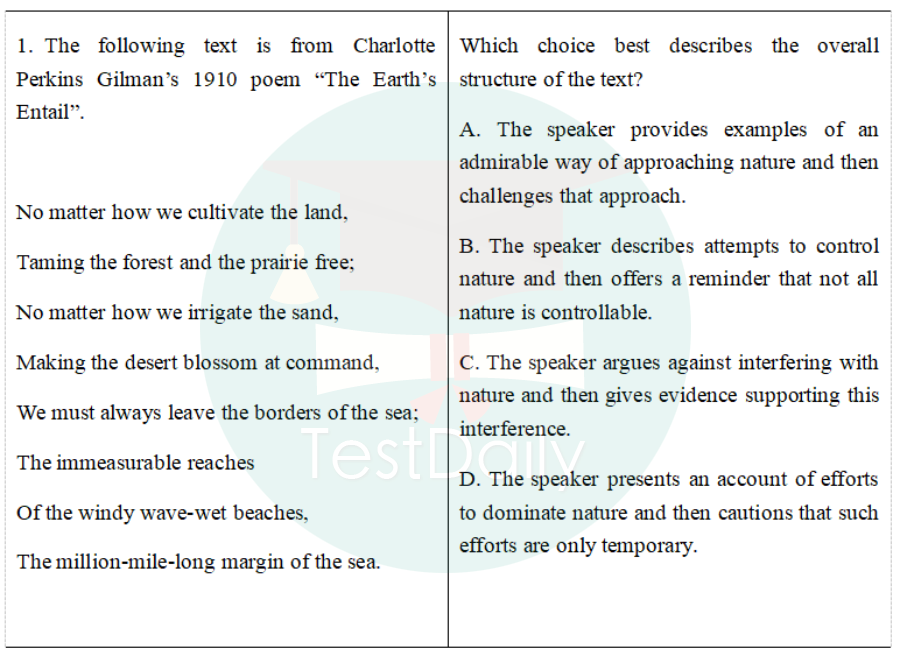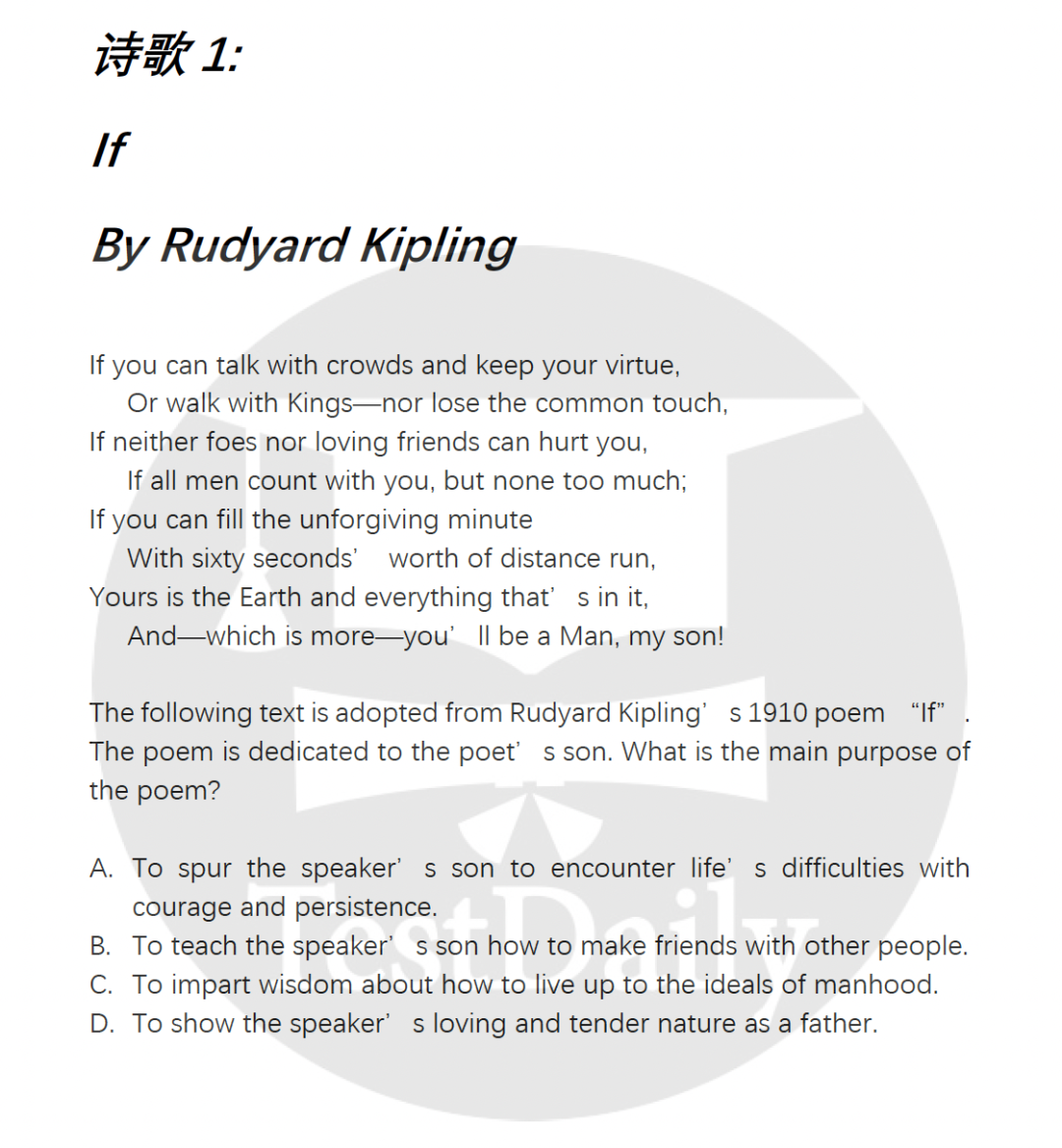诗歌,简短,晦涩,修辞多样。读完一篇诗歌,可能比读纸考历史更不知所云。
当同学们看到CB样题中的诗歌题材:
Student A:我是个
莫得感情的机器人,读不懂诗歌里的弯弯绕绕...
Student B:我
单词很拉垮,诗歌又那么短,碰到生僻古旧单词应该怎么推测大意?
Student C:我
做题特慢,如果认真品读诗歌情感和主题,肯定做不完题的!
不要着急,TD叮当猫这不就来了么,让我们来给大家开个道,详细讲一讲:
1)诗歌通常
怎么出题?
2)有什么
阅读小技巧?
3)需要注意什么
易踩坑位?
话不多说,先来放机考真题!
机考SAT真题练习1
请先捂好自己的答案,一起来和我分析题目~
机考SAT题目解析1
1)前4行:
There shall be new roads wending,
A new beating of the drum—
读到了new —— 情感倾向
positive,at least not bad,有那么一丝丝希望的气息
Men’s eyes shall have fresh seeing,
Grey lives reprise their span—
读到了fresh —— 情感倾向依旧
positive
2)转折后:
But under the new sun’s being,
Completing what night began,
But表示转折 —— new sun后night began ——
周而复始
There’ll be the same backs bending,
The same sad feet shall drum—
读到了same —— 和之前new相对立 —— 周而复始
也读到了sad ——
night的情感偏negative
When this night finds its ending
And day shall have come.....
读到了night ends & day shall come ——
negative情感倾向的night过去,再次迎来
新的一天
分析完,答案不言而喻,选A!
A. To consider how the repetitiveness inherent in human life can be both rewarding and challenging
Repetitiveness - 对应最后6行
Rewarding - 对应前4行
Challenging - 对应but转折后的4行
How - 通篇诗歌都在介绍
光做题还不够,我们还得
从一道题中总结普适经验和技巧,举一反三~
机考SAT做题小Tips
1.关注并列关系,概括大致意思/情感倾向:比如:
There shall be new roads wending,
A new beating of the drum—
Men’s eyes shall have fresh seeing,
Grey lives reprise their span—
均表示情感倾向positive——总能看见something new。
这样概括后,
即时并列段内出现生词,也不影响我对这一层次的重点理解。
2. 关注转折逻辑,推测出后文和前文的关系。比如:
But under the new sun’s being,
Completing what night began,
相较于前4行,不仅仅有new sun’s being,
还有night began。所以,but后加入了新信息。
3. 关注情感倾向形容词。比如:
Men’s eyes shall have fresh seeing & The same sad feet shall drum里,一个是fresh,另一个是sad。说明前后情感倾向不一致。
再比如A new beating of the drum & The same sad feet shall drum里,一个是new,另一个是same。
相信你们已经把小技巧收入囊中。我们再来看一道题,用上面所说的方法练练手~
机考SAT真题练习2
答案:B
聪明的你选对了么,来听听讲解吧!
机考SAT题目解析2
1)关注并列关系:
No matter how we cultivate the land,
Taming the forest and the prairie free;
No matter how we irrigate the sand,
Making the desert blossom at command,
前4行字格式一样,均为no matter,说明其想表明的意思或情感应该是类似的。我们可以summarize them by using our own words —— we can control nature, such as desert, forest and prairie. But...
2)关注transition phrase:
"no matter"——“无论”,引出第5行开始的某种对立关系。结合我们对前4行的理解:无论我们怎么样控制那些自然环境,但我们仍.... (Despite the fact that we can control and shape the land...)
3)关注情感倾向形容词:
The
immeasurable reaches & The
million-mile-long margin of the sea. 后4行在强调the size and power of the ocean. 结合上文提到的contrast转折关系,
contrast前是
we can control,那么
contrast后the powerful and immeasurable ocean就应该是uncontrollable的。
以上就是我们需要掌握的诗歌的做题方法和小技巧了,接下来需要的就是重复练习啦。
但是机考题目有限,我们还可以从哪里去练习诗歌这类文章呢?你看,我们这不就来了!
TD SAT教研组的老师们已经手动给大家找好了符合机考难度的诗歌文段,并且依据机考的考试特点编纂了30道题供大家练习,以下是诗歌资料部分页面展示:
本文作者
TD福利 & 领取方式
TD SAT教研组已经为大家准备好这份
【机考SAT诗歌赏析&题目练习】,现
免费分享给大家练习,只需要扫描下方二维码,添加马甲微信,并发送暗号
【机考诗歌30篇】,即可领取,让TD帮你高效提分,少走弯路吧!

推荐阅读
SAT语法如何备考?复习规划讲座:纸考机考详解/备考计划方法/必考真实的真题练习|附SAT真题等备考资料免费下载领取!
2023年1月SAT机考考情回顾:阅读/语法/数学,第二个module时间紧,难度大|附SAT真题免费下载领取!
SAT语法:区分定语从句的限定和非限定 |附SAT语法专项备考资料免费下载领取!
SAT阅读培训技巧:高强度从330分提高到380分,注意这些易错点!|附SAT历年真题免费下载领取!
2022年11月澳门SAT考情回顾:阅读语法常规,数学module 2偏难|附SAT真题免费下载领取!












